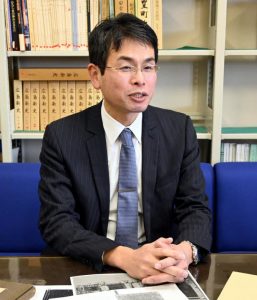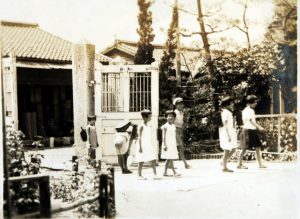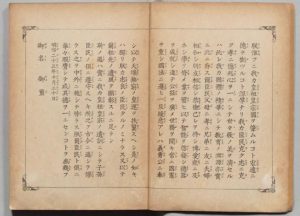Does Japan’s Imperial Rescript on Education incorporate “democratic concepts”? We ask Masaharu Ishida, associate professor, Hiroshima University
Jan. 15, 2024
Hiroshima City Mayor Matsui uses excerpts from IRE to train new civil servants, in deviation from original interpretation
by Kyoko Niiyama and Hiromi Morita, Staff Writers
It was recently discovered that Hiroshima City Mayor Kazumi Matsui has used parts of Japan’s Imperial Rescript on Education (IRE) as training material for newly hired civil servants since fiscal 2012, the year after he was first appointed. The discovery has led to protests by A-bomb survivor organizations and peace groups. Mr. Matsui has explained his thinking by saying that the IRE uses some expressions that are based on democratic concepts. To find out, the Chugoku Shimbun interviewed Masaharu Ishida, associate professor of modern education history at the Hiroshima University Archives.
Are democratic ideas included in the IRE?
If we apply the idea of democracy as defined in modern Japanese society, or the sovereignty of the people, it is clearly wrong to say that the IRE incorporates democratic ideas. The Imperial Diet was established in Japan’s prewar national system, but it was organized under the constraint that sovereignty rested with the emperor. More precisely, the IRE was based on the concept of constitutional monarchy.
How was the IRE used in Hiroshima before the war?
The IRE was deemed to be the standard of so-called ‘moral education’ implemented at that time nationwide, not only in Hiroshima. As for primary education, something known as the ‘fundamental principles of elementary school rules,’ established in 1891, stipulated that such moral education be carried out on the basis of the IRE. The entire IRE text was included in textbooks.
Did schoolchildren only come into contact with the IRE at times of moral education?
No. Schools began to hold ceremonies using the IRE on national holidays such as the emperor’s birthday. In those ceremonies, the school principal would read the IRE and provide instructions to gathered students, teachers, staff, and local citizens. Each school handled, as sacred items, copies of the IRE and a portrait of the emperor and empress, which had been distributed by Japan’s Ministry of Education (present-day Ministry of Education, Culture, Science and Technology). From the first year of the Showa period (1926–1989), hoanden, a special school structure designed for housing copies of the IRE and the imperial portrait, began to be constructed in all schools.
The IRE seems to have been sanctified and linked with militarism?
When children passed in front of the hoanden on their way to school, they would fix their clothes and postures and bow deeply. In Hiroshima, a photograph taken between the mid-1930s and the mid-1940s captured a child bowing to the hoanden at the present-day Hirose Elementary School, located in what is now Hiroshima’s Naka Ward. There are testimonies and personal accounts from children in Hiroshima that still exist, describing how they stood at attention “without moving or coughing even once” while listening to the principal’s reading from the IRE or while they “recited” the document themselves.
How was the IRE positioned after Japan lost the war?
In response to a New Year’s edict known as the emperor’s “Declaration of Humanity,” Japan’s Ministry of Education notified schools that they should abandon their reliance on the IRE, which was based on the concept of the emperor’s divinity, as the sole basis for education. In Hiroshima, by the end of 1945, the imperial portraits were collected and the school hoanden designed for the sacred objects demolished. In 1948, the Lower House of Japan’s Diet, or parliament, passed a resolution for removal of the IRE, and the Upper House then invalidated the document.
Movements to validate the IRE have happened repeatedly.
The many recent opinions in support of the IRE appear to derive from an arbitrary perspective. The assertion that the IRE incorporates democratic ideas seems to be based on an incorrect assumption made by those who don’t understand its original meaning. That perspective deviates from the original interpretation expressed in an official explanation about the document considered to be the official pre-war IRE guidelines.
The city’s excerpts of the IRE used in its training material call for concrete virtues (moral acts) for the emperor’s subjects (the people), including ‘being on good terms with siblings,’ ‘extending benevolence to all,’ and the ‘pursuit of learning and cultivation of the arts.’ However, such virtues modify the descriptions that came later, which read “and thus help guard and maintain the prosperity of Our Imperial Throne coeval with heaven and earth,” information that is not included in the training material. According to the official rescript explanation, virtues that would assist in maintaining the Imperial Throne were deemed to be right action.
Mr. Matsui wants to continue using the IRE as training material.
The expressions such as ‘being on good terms with siblings’ are based on feudalistic, hierarchical master-servant relationships, a concept at odds with our present-day emphasis on equal and fair relationships among individuals. The section calling for the ‘pursuit of learning and cultivation of the arts’ can be interpreted as meaning that learning and study not deemed useful for the nation are worthless. The debates surrounding the IRE should be based on faithful interpretations of the source material. I think the mayor should reconsider his thoughts on this issue after coming to terms with the original interpretation.
Danger of developing opinions based on partial knowledge
Last year, a book drawing attention in Japan that was published by Iwanami Shoten posed the question, “Did the Nazis also do some ‘good things’?” In the book, two historians take a positivistic approach to the question of why online and other debates about the idea that the Nazis might also have done some good frequently arise. What was the purpose behind such “good things” and did that aim truly lead to “good” results? The publication warns of the danger of moving straight from partial “knowledge”' to “opinion,” emphasizing the need for “interpretation” that takes into account historical context and an overall view of things.
Hiroshima’s case seems to be close to the idea that there were also some “good things” that happened. The city uses only parts of the IRE to train its staff. As a mindset for living, the material states the importance of “accepting the positives among everything developed by predecessors and passing them on to younger generations.” Mr. Matsui also mentioned his idea that “some parts of the IRE are useful” and that “the IRE provides actual examples of how to think about things from diverse viewpoints.”
Some might view the phrasing of the materials on its surface as a “good thing.” However, such opinions are based on an incorrect interpretation, as pointed out by Mr. Ishida in our interview with him.
Under the Constitution of Imperial Japan, the IRE played the role of incorporating Japanese citizens into a national mobilization system centered on the emperor. The document was considered sacred and used to control the minds of even children. In Hiroshima, countless lives were taken by the atomic bombing, which the U.S. justifies as a way “to end the war.” Included among the A-bomb victims were students who had bowed their heads to the hoanden housing the sacred items and who had been mobilized to work in Hiroshima’s downtown “for the good of the nation.”
Why is the training material based on the IRE when the material is simply being used to explain a universal consciousness for civil servants in the workplace and the importance of considering matters from diverse viewpoints? The question now is how Hiroshima will confront its own history as the A-bombed city.
Profile
Masaharu Ishida
Born in 1976, Masaharu Ishida graduated with a doctoral degree from the Graduate School of Letters at Hiroshima University in 2005. Mr. Ishida has served in his current post since 2016, after working as a researcher under the Research Fellowships for Young Scientists program of the Japan Society for the Promotion of Science and as an assistant professor at the Hiroshima University Archives. He has authored a publication titled Sengo Nippon no Kyokasho Mondai (in English, ‘History textbook issues in post-war Japan’). He now lives in Higashihiroshima City.
Keywords
Imperial Rescript on Education (IRE)
Issued under the name of the Meiji Emperor in 1890, the rescript was the basis of morals for Japanese citizens and a guiding philosophy for education. The document positioned the loyalty of the people of Japan as “subjects” of the emperor to be the “essence of national polity,” and listed filial piety, marital harmony, benevolence, and volunteer service as important virtues. The rescript was sanctified and linked to militaristic education in the early years of Japan’s Showa period (1926-1989). After Japan suffered defeat in the war, both the Lower and Upper Houses of Japan’s Diet voted to do away with the rescript.
(Originally published on January 15, 2024)










